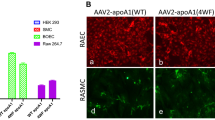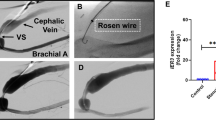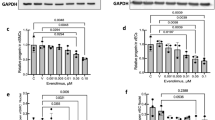Abstract
Different lipids and cationic polymers were tested in vitro for their ability to transfect rabbit aortic smooth muscle cells and human endothelial cells with lacZ marker gene. Toxicity of the complexes was evaluated with MTT assay. Selected plasmid–polymer complexes with different charge ratios were then tested for in vivo gene transfer efficiency using adventitial gene transfer by placing a silastic gene delivery reservoir (collar) around the carotid artery. Transfection efficiency was determined by X-gal staining 3 days after the gene transfer. Based on in vitro experiments, fractured polyamidoamine dendrimers and polyethylenimines (PEI) were selected for in vivo experiments. Fractured dendrimers (generation 6, ± charge ratio of 3) had the highest in vivo gene transfer efficiency (4.4% ± 1.7). PEI with mol- ecular size of 25 kDa (± charge ratio 4) was also effective (2.8% ± 1.8) in this model. PEI of 800 kDa showed a constant but modest gene transfer efficiency (1.8% ± 0.1) with all charge ratios. A low level gene transfer was also detected with naked DNA (0.5% ± 0.3). No signs of inflammation were seen in any of the study groups. We show here that in vitro cell culture experiments can be used to identify efficient in vivo gene transfer methods for arterial gene therapy, but the charge ratios for each complex must be optimized in vivo. It is concluded that fractured dendrimer and PEI are efficient gene delivery vehicles and can be used for arterial gene therapy via adventitial gene delivery route.
This is a preview of subscription content, access via your institution
Access options
Subscribe to this journal
Receive 12 print issues and online access
$259.00 per year
only $21.58 per issue
Buy this article
- Purchase on Springer Link
- Instant access to full article PDF
Prices may be subject to local taxes which are calculated during checkout


Similar content being viewed by others
References
Nabel EG, Nabel GJ . Complex models for the study of gene function in cardiovascular biology Annu Rev Physiol 1994 56: 741–761
Simons M et al. Antisense c-myc oligonucleotides inhibit arterial smooth muscle cell accumulation in vivo Nature 1992 359: 67–70
Isner JM et al. Clinical evidence of angiogenesis after arterial gene transfer of phVEGF165 in a patient with ischaemic limb Lancet 1996 348: 370–374
Gibbons GH, Dzau VJ . Molecular therapies for vascular diseases Science 1996 272: 689–693
Stephan DJ et al. A new cationic liposome DNA complex enhances the efficiency of arterial gene transfer in vivo Hum Gene Ther 1996 7: 1803–1812
Feldman LJ, Isner JM . Gene therapy for vulnerable plaque J Am Coll Cardiol 1995 26: 826–835
Finkel T, Epstein SE . Gene therapy for vascular disease FASEB J 1995 9: 843–851
Ylä-Herttuala S . Vascular gene transfer Curr Opin Lipid 1997 8: 72–76
Ylä-Herttuala S et al. Transfer of 15-lipoxygenase gene into rabbit iliac arteries results in the appearance of oxidation-specific lipid-protein adducts characteristic of oxidized low density lipoprotein J Clin Invest 1995 95: 2692–2698
Laitinen M et al. Gene transfer into the carotid artery using an adventitial collar: comparison of the effectiveness of the plasmid–liposome complexes, retroviruses, pseudotyped retroviruses, and adenoviruses Hum Gene Ther 1997 8: 1645–1650
Keogh A-C et al. High efficiency reporter gene transfection of vascular tissue in vitro and in vivo using a cationic lipid–DNA complex Gene Therapy 1997 4: 162–171
Barr E et al. Efficient catheter-mediated gene transfer into the heart using replication-defective adenovirus Gene Therapy 1994 1: 51–58
Laitinen M et al. VEGF gene transfer reduces intimal thickening via increased production of nitric oxide in carotid arteries Hum Gene Ther 1997 8: 1737–1744
Morgan RA, Anderson WF . Human gene therapy Annu Rev Biochem 1993 62: 191–217
Haensler J, Szoka FC Jr . Functionalization of polyamidoamine cascade polymers and their use for efficient transfection of cells in culture Bioconjug Chem 1993 4: 372–379
Tang MX, Redeman CT, Szoka FC Jr . In vitro gene delivery by degraded polyamidoamine dendrimers Bioconjug Chem 1996 7: 703–714
Kukowska-Latallo JF et al. Efficient transfer of genetic material into mammalian cells using Starburst polyamidoamine dendrimers Proc Natl Acad Sci USA 1996 93: 4897–4902
Tang MX, Szoka FC . The influence of polymer structure on the interactions of cationic polymers with DNA and morphology of the resulting complexes Gene Therapy 1997 4: 823–832
Baker A et al. Polyethylenimine (PEI) is a simple, inexpensive and effective reagent for condensing and linking plasmid DNA to adenovirus for gene delivery Gene Therapy 1997 4: 773–782
Boussif O et al. A versatile vector for gene and oligonucleotide transfer into cells in culture and in vivo: polyethylenimine Proc Natl Acad Sci USA 1995 92: 7297–7301
Meunier-Durmort C et al. Adenovirus enhancement of polyethylenimine-mediated transfer of regulated genes in differentiated cells Gene Therapy 1997 4: 808–814
Rios CD et al. Adenovirus-mediated gene transfer to normal and atherosclerotic arteries Arterioscler Thromb Vasc Biol 1995 15: 2241–2245
Laitinen M et al. Adenovirus-mediated gene transfer to lower limb artery of patients with chronic critical leg ischaemia Hum Gene Ther 1998 9: 1481–1486
Qui L et al. Efficient transfer of genes into murine cardiac grafts by starburst polyamidoamine dendrimers Hum Gene Ther 1998 9: 553–560
Roberts JC, Bhalgat MK, Zera RT . Preliminary biological evaluation of polyamidoamine (PAMAM) Starburst dendrimers J Biomed Mat Res 1996 30: 53–65
Plank C, Mechtler K, Szoka FC Jr, Wagner E . Activation of the complement system by synthetic DNA complexes: a potential barrier for intravenous gene delivery Hum Gene Ther 1996 7: 1437–1446
Zhu N, Liggit D, Liu Y, Debs R . Systemic gene expression after intravenous DNA delivery into adult mice Science 1993 261: 209–211
Ylä-Herttuala S et al. Colocalization of 15-lipoxygenase mRNA and protein with epitopes of oxidized low density lipoprotein in macrophage-rich areas of atherosclerotic lesions Proc Natl Acad Sci USA 1990 87: 6959–6963
Author information
Authors and Affiliations
Rights and permissions
About this article
Cite this article
Turunen, M., Hiltunen, M., Ruponen, M. et al. Efficient adventitial gene delivery to rabbit carotid artery with cationic polymer–plasmid complexes. Gene Ther 6, 6–11 (1999). https://doi.org/10.1038/sj.gt.3300800
Received:
Accepted:
Published:
Issue Date:
DOI: https://doi.org/10.1038/sj.gt.3300800
Keywords
This article is cited by
-
Inhibition of neointimal hyperplasia in a rabbit vein graft model following non-viral transfection with human iNOS cDNA
Gene Therapy (2013)
-
Truncated vesicular stomatitis virus G protein improves baculovirus transduction efficiency in vitro and in vivo
Gene Therapy (2006)
-
Water-soluble lipopolymer as a gene carrier to corpus cavernosum
International Journal of Impotence Research (2005)
-
Bone regeneration in a rat cranial defect with delivery of PEI-condensed plasmid DNA encoding for bone morphogenetic protein-4 (BMP-4)
Gene Therapy (2005)
-
Improved chitosan-mediated gene delivery based on easily dissociated chitosan polyplexes of highly defined chitosan oligomers
Gene Therapy (2004)



